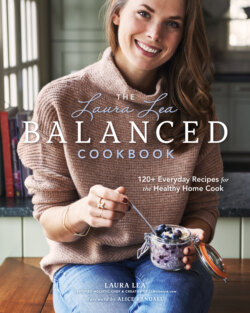Читать книгу The Laura Lea Balanced Cookbook - Laura Lea - Страница 51
На сайте Литреса книга снята с продажи.
Оглавлениеfood without overcooking it. You will often
see me use the word “sauté,” but note I rarely
request high heat. My high heat is really
medium or medium high, and this is because
I like to prevent the fats from smoking, which
makes them rancid. So I will ask you to start
with a sauté for color and flavor, then I’ll
often ask you to continue cooking a little
longer at a lower temperature.
• Deglaze. When you sear meat or vegetables,
it often leaves behind brown bits. These are
gold. “Deglazing” refers to adding water or
stock to a pan, then scraping with a spatula
to loosen the brown bits. Unless they are
actually burnt, keep this deglazed juice in
the dish to add richness and flavor.
• Getting the most out of your citrus. To
maximize the amount of juice you get
out of your lemons and limes, roll them
under the palm of your hand on the
countertop, applying pressure. Do this for
10 to 15 seconds; the heat and pressure
from your hand help loosen the insides,
releasing more juice.
• Properly pitting an avocado. Carefully poke
the avocado where it is widest with a sharp
knife, until it hits the seed. Drag the tip of
the knife down and turn the avocado with
your hand, so that you are creating one long
vertical cut all the way around. Release the
knife and twist the two sides in opposite
directions. You should have one side left with
the pit. Hold that avocado half face-up in the
palm of your non-dominant hand. With your
dominant hand, hit the pit with the knife
edge, just hard enough to stick. Twist the
avocado and the knife in opposite directions.
The pit should pop out. Hit the knife gently
against a cutting board to get the pit off.
• Keeping a clean kitchen. A trick my mama
taught me, which her mama taught her, is to
keep a mixing bowl or two for trash and/or
compost on the counter with you while you
work. Having the bowls by your side makes
it much easier and faster to clean up. At the
end of the cooking session, you can dump
them in the trash and/or compost.
• Consolidating spices. When cooking a recipe
with more than one or two spices, I suggest
mixing them together in a small bowl before
beginning the recipe. That way, when it’s
time to add the spices, all you have to do is
dump in your pre-mixed spices.
• Substituting eggs. Don’t eat eggs, or want to
veganize a baked goods recipe? Substitute
a chia “egg.” To make a chia “egg,” which is
equivalent to one large egg, whisk together
1 tablespoon chia seeds and 3 tablespoons
water. Allow mixture to sit for 10 to 15
minutes, whisking every 2 to 3 minutes, until
it has thickened to a gel-like consistency. At
this point, you can add it to the recipe. Note:
I have not tested all my baked goods recipes
with chia “eggs” instead of regular eggs.
Historically, I have had great success with
this substitution, but please know that your
outcome might be different than mine.
• Shortcut for room temperature eggs.
When baking, it is important to use room
temperature eggs instead of cold eggs.
Cold eggs can affect the baking time, and
they also can result in a denser product—
something that is a hazard with grain-free
baking anyway. I always forget to take my
eggs out an hour before I’m going to bake,
so I simply place them in slightly lukewarm
(NOT warm) water for 5 minutes, and voila!
They’re perfect and ready for cracking.
• Other uses for lemon rinds. When you’ve
squeezed the juice out of a lemon, you can
rub the cut side over a wooden cutting board
to help remove any garlic or other strong
Remove
avocado flesh
by slicing it
into slabs in
the shell, and
then removing
with a spoon.
